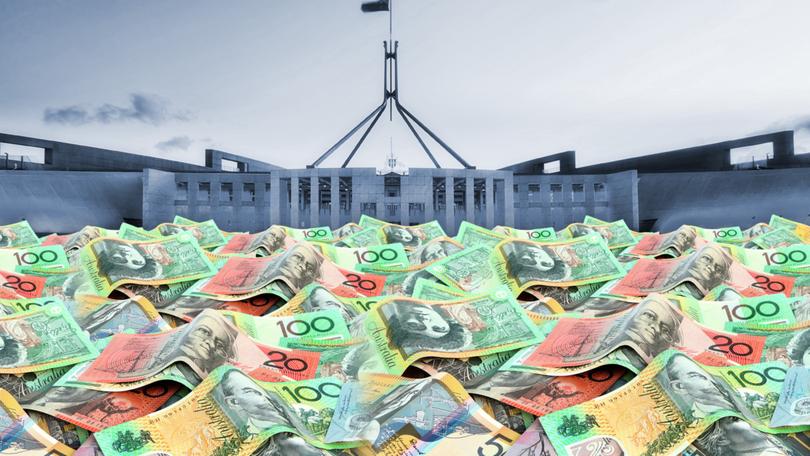Australia’s economic reckoning: Higher rates, higher stakes as US Federal Reserve spooks markets

When the US Federal Reserve spooked markets last week by saying it wouldn’t cut interest rates as much as expected, it may have marked the end of one of the most extraordinary periods in economic history.
If true, the implications are enormous and call into question whether the long-term spending commitments revealed in last week’s MYEFO are even more unsustainable.
Decades of global debt and deficits
Sign up to The Nightly's newsletters.
Get the first look at the digital newspaper, curated daily stories and breaking headlines delivered to your inbox.
By continuing you agree to our Terms and Privacy Policy.For over a decade, ultra-low interest rates were the norm — driven down to near zero as a consequence of the Global Financial Crisis and the COVID pandemic.
That has allowed households and businesses to borrow at historically cheap levels. Governments too, have exploded debt over the period to shore up their economies.
But there is a sting in the tail of all that spending. The more debt governments take on, the more the market wants to be compensated for the risk.
As we enter an era where higher government spending on defence, an ageing population and the energy transition, it raises the overall demand for capital in the economy.
Sustained fiscal deficits, like those revealed in the MYEFO last week, often require governments to issue more debt, expanding the supply of bonds in the market and further driving up yields.
This heightened demand competes with private-sector borrowing, at a time when there is an explosion in demand for capital to finance artificial intelligence and its huge energy needs. That will also put upward pressure on interest rates.
But the low-rate era is now over. As central banks recalibrate borrowing costs to align with higher neutral rates, the global economy is entering a new phase where structural interest rates will settle well above their pre-pandemic lows.
“The neutral rate — once an abstract concept debated among economists — is now central to monetary policy,” said Luci Ellis, Chief Economist at Westpac, and a former Deputy Governor of the Reserve Bank of Australia.
“The period of ultra-low rates from the GFC to the pandemic is just no more . . . the global rate structure is higher.”
When the bill falls due
At $36 trillion and 120 per cent of GDP, US Government debt continues to hit record highs as the country runs deficits last seen at the peak of the GFC, COVID and World War II. Throw in President-elect Donald Trump’s plan to pass tax cuts and that will blow out further. The interest payments on that debt now exceed the US’s defence budget.
It has senior statesmen increasingly worried. Speaking at the Peterson Institute of International Economics this month, Lawrence Summers, the former US Treasury Secretary and Robert Zoellick, former World Bank president starkly warned of the consequences of ever-increasing debt.
“You have to deal with the fact that the US Congress is running big deficits. And at least so far from what we’ve seen in the Trump administration, proposals for the budget, they’re not going to make that better. So that’s going to exacerbate the effect,” Mr Zoellick said.
Summers points to five fundamental shifts that have taken place this century; an ageing population, increased defence and security spending, a higher cost of providing government services, more wealth distribution as a result of US economic inequality, and substantially higher interest payments on debt.
“Whatever your view about the right size of government was 25 years ago, if you want to have that level of government services today, it’s going to be 5 per cent of GDP or so more expensive. There’s no way to go back to the golden days by having more efficiency because we just have these things that have happened, like an ageing society,” Summers said.
“I don’t think anybody in political leadership has really recognised that explicitly and explained it. Therefore, there’s no acceptance of a scaling back of the level of government services that people had expected, or of the need for taxes to be more burdensome relative to incomes than they have been in the past.”
The difficulty in making those hard choices was made apparent Friday when Congressional Republicans ignored a command from Mr Trump and passed a funding bill that averted a pre-Christmas government shutdown.
In his previous term, Mr Trump presided over the longest shutdown in US history — 35 days — as he tried to negotiate a higher US debt ceiling to pay for a border wall.
While Trump has said he wants to “terminate or substantially extend” the debt ceiling, Elon Musk regularly rails against “government bloat” on social media.
But markets are aware of the risk of continued deficit spending, and are also concerned about how the lack of constraint is fuelling inflation. That is, 10-year US treasury yields spiked last week when the Federal Reserve declared it would reduce the amount of rate cuts from four to two next year. In their deliberations, 15 of the 19 members of the Fed’s interest rate setting committee declared they were concerned about inflation.
With the spike in 10-year treasury yields — effectively the global benchmark for the price of money — the past 17 years of historically low rates now look more and more like an anomaly.
As the largest, most liquid market, US 10-year yields affect the price of risk around the world. Every other debt, including countries and corporations, uses that as the benchmark for how they set their price of borrowing.
The Australian context
Australia’s debt trajectory, though smaller in scale, is set to surpass $1 trillion next year, with interest payments projected to grow by 11 per cent annually over the next decade. This leaves the Albanese government grappling with increasing demands for spending on healthcare, defence, and the energy transition.
Compounding the issue is the reliance on revenue from volatile commodities like iron ore. With China’s urbanisation slowing, the revenue windfalls that helped offset deficits during the boom years are unlikely to return.
Treasury projections already assume muted revenue growth, underscoring the urgency of structural budget repair.
“There’s a constraint on policy that ultimately servicing the debt that you’ve already got becomes such a big share of your budget that it becomes a political issue,” Ms Ellis said.
“If it’s all domestic currency debt, as it is for Australia, you can always print more but it does tend to mean that you’re going to have higher rates, you’re going to have higher inflation.”
That means governments can no longer rely on cheap money to fund ambitious long-term commitments without hard decisions on tax reform or spending cuts.
The Impact on households and businesses
For Australian households, the implications are immediate and painful. Mortgage rates have climbed above 6 per cent, and stagnant wage growth means that real incomes are eroding.
Younger Australians are particularly vulnerable, locked out of home ownership and burdened by rising costs.
Higher interest rates erode borrowing power, making it more difficult to get on the ladder. But higher rates should also reduce the kind of price boom that pushed housing out of reach in the past decade.
In the meantime, mortgaged households exposed to higher repayments and reduced disposable income are unlikely to ever see a return to the 2 per cent teaser rates of the pandemic.
The reset in interest rates will also affect the private sector. Just as the country is looking to generate growth beyond public spending, the conditions for investors will get harder.
“The global shift to higher structural rates means some projects that were economic five, 10 years ago will no longer be viable,” Ms Ellis said, meaning businesses will be less inclined to take big, risky bets to create the industries of the future.
What must be done?
The Albanese government faces stark choices. Stealth tax increases, such as bracket creep, can no longer shoulder the fiscal burden alone.
Genuine tax reform is unavoidable, whether by broadening the GST or revisiting concessional superannuation tax breaks. The decision today to levy a minimum 15 per cent tax on multinationals earning $1.2 billion in Australian revenue is a good start.
Australia is still one of the lucky countries whose debt at 40 per cent of GDP is still low relative to much of the developed world. But the looming change in long-term interest rates comes as budget deficits are forecast until the middle of the next decade.
The world has enjoyed a once in a millennium windfall from low interest rates and Australia a once in a century windfall from iron ore.
The odds have been in our favour but the game has changed.

